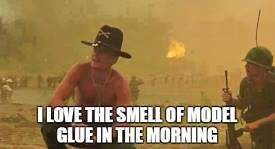 by Convair990A » Mon Jun 27, 2022 2:45 am
by Convair990A » Mon Jun 27, 2022 2:45 am
Its a good question that needs to be asked periodically. Unfortunately, you will probably get a different answer for every day of the week.
Milliput serves a good purpose and many people use it very successfully for seam and gap filling applications. It's been years since i used it but i can see it being very useful for 90-degree joints and corners (provided you have the right tools to work it, and provided you can remove all the unwanted excess before it really hardens up).
Super Glue/ CA can work as a good gap filler, though the thinner viscosities by themselves don't have much body to them and really need to be thickened up, either by mixing with a thicker bodied CA, or mixing in with Talc (NOT Baking Soda). Some people sprinkle in Acrylic Dental resin powder, but i've not really gotten the hang of it yet so until then i'm reluctant to expand on that one.
Thicker bodied CAs sand just fine..... as long as you sand them relatively soon after applying, i.e., one or 2 hours. Over 24 hours the stuff just sets up hard as a rock, and you need to use very aggressive sanding tools to make any headway. Plus at that stage you run into the problem of the glue being harder than the surrounding plastic.
I'm a big proponent of using thin pieces of strip styrene and sheet for filling larger gaps, partly because of their compatibility with the kit parts, partly because of their similar hardness characteristics.
An experiment that i'm doing now is, i'm plugging the windows in my Roden 720 with rectangular section styrene bar stock. I dip the end of the bar stock in CA, then press them in/through the window holes "wet"... kind of like installing fasteners in real aircraft as a corrosion control measure. Then i brush (not spray) CA accelerator on then and carefully nip away as much of the protruding material as i can and sand the rest flush. So far the test results have been good.
Mr Surfacer 500 is great stuff, as is Mr Dissolved putty. Much has been written about its easy cleanup with a cotton bud dipped in Mr Color Thinner, and it does work but with one important caveat: It's very easy to accidentally remove too much filler, and so then you have to re apply more and repeat the process. It sands just fine, it's just that i think the technique has been oversold.
Those of you who followed my VC10 build over on Facebook or Britmodeller probably saw some of my unique solutions for overcoming some awkward fit issues. Not to pat myself on the back but if you look at those, it explains fairly well how it works.
One last technique i tried for cabin windows is, i laid a strip of Tamiya tape along the outside of the fuselage along the window belt line, and i tried pouring in 30 minute epoxy from the backside. In theory this seemed like a good idea, but unfortunately air bubbles affected probably every other cabin window. I managed to recover from this by filling from the outside with medium CA, but i had to do this one window at a time, and it negated the whole purpose of the epoxy- to save time.
As some of you know from my build narrative, i tried applying Tamiya White Putty over the clear cabin windows RODEN provides, but i had many issues with the putty pulling out of the windows when the masking was removed.
In summary: There is no single, fool proof, one-size-fits-all approach to gap fillers. They all have pluses and minuses and all of them should be in you arsenal of tricks. If you're not sure which technique to use to fill a gap, i recommend starting out by asking fellow modelers who built the same subject how *they* went about addressing their fit challenges, and go from there.
I know it seems like a simple question to ask, but the more deeply you investigate, the more it becomes evident that there is no easy answer.

